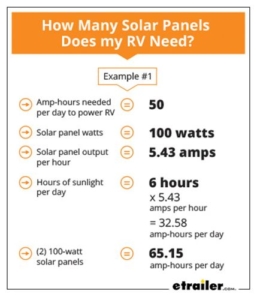Have you been thinking about upgrading your RV to add solar power? There are a lot of options on the market for solar panel options and it can make the decision feel overwhelming. It’s not as simple as deciding you want solar power and getting it done. You have to think about how much power you need along with what size panels and the number of them it will take to make that happen.
And not only do you need to think about how much solar power you need, you first need to know what you can run on solar. If you’re considering making the switch and just aren’t sure where to start, this will help.
How much power do you really need?
Before just deciding to add some solar panels to the roof of your RV, you need to determine how much solar power you need. This isn’t something that you want to incorrectly estimate or else you’ll end up with no where to store the energy or not enough.
The first thing you need to do is calculate how much power you use. The next time you go camping use a battery monitor to track your battery level. Watching this will help you see how much power you use each day.
Keep in mind that you never want to drain a lead acid batter below 50%. If you do, you can end up causing damage which shortens the life of the battery itself.
When it comes to monitoring your battery, you may find it worth investing in a battery monitor or gauge if your RV doesn’t have one. This is especially important if you’re going to be boondocking often. Look for one that shows you the percentage of the battery remaining instead of the voltage. This makes it easier to read and understand what your consumption truly is.

Adding up your usage
Another option for calculating your average power usage is to do the math. You can find resources online to help you estimate your power consumption based on your activity. For example, you can see how many watts you need for watching television based on how many hours you watch per day.
Using this method can make it tricky to get a realistic estimate of your usage. Not many RVers want to spend time carefully tracking their activities with a stopwatch to know how long they’re doing each thing. It’s also difficult to determine usage based on specific circumstances. For example, what if it rains and you end up in the RV for a few days?
Monitoring as you camp
The above example is why it can be most helpful to monitor your usage as you’re camping. Go boondocking for a few days and do everything you would normally do when enjoying yourself while RVing. Don’t try to adjust your activity to use less power. Just do what you normally would while camping.
During this trip, keep track of your battery level (remember if you have a lead-acid battery that you don’t want to let it go below 50%).
Then, you can use this information to determine what your average usage is. For example, if you reach 50% of a 200-amp-hour battery after two days, then you know you’re averaging 50-amp hours a day.
Tips for saving energy
As you switch over to solar power, you may want to work on making some upgrades and replacements to help you use less energy. This can include things like:
- Taking shorter showers
- Using natural resources to your advantage. Park in the shade on hot days.
- Switch to LED bulbs
- Make sure you turn off things when not using them
- Don’t leave devices charging if they don’t need to
How many solar panels do I need for my RV?
Once you’re armed with the information about your energy needs, you can work on determining how many solar panels you need. Different solar panels produce different amounts of power.
Solar panels will produce the wattage they are designed to in perfect conditions. That means a 100-watt solar panel should be producing 100 watts of energy. However, you’re not likely to find those “perfect” conditions. This is why you need to account for things like cloudy days, temperature, daylight hours and other things that could impact the solar panel production. It’s helpful to use an online calculator to determine solar panel production based on time of year and geographical location.
Keep in mind, this average: a 100-watt solar panel will produce 30-watts of solar power each day. It’s also suggested that you have a battery with the same watt capacity as your solar panel production. If you have a 200 amp-hour battery, you’ll want the same amount of solar power. It’s also recommended to keep a 20% cushion for those days when you don’t get the sunshine you need.
Now it’s time to do the math. Here’s an example:
- You need 50 amp-hours of power each day.
- Your solar panel is 100 watts
- Per hour your solar panel output is 5.43 amps
- You’re camping where there is 6 hours of sunlight
- Multiple the number of sunlight hours by the solar panel output per hour (6 x 5.43 = 32.58)
- This means in order to have at least 50 amp-hours per day, you will need two 100-watt solar panels

Got questions?
If you have more questions on adding solar panels to your RV, contact our RV Service and Maintenance Department.
